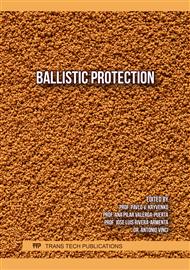[1]
A. Bhatnagar, Ed., Lightweight Ballistic Composites: Military and Low-Enforcement Applications. London: Woodhead Publishers, (2006).
Google Scholar
[2]
B.A. Cheeseman, T.A. Bogetti, Ballistic impact into fabric and compliant composite laminates, Compos. Struct. 61 (2003) 161-173.
DOI: 10.1016/s0263-8223(03)00029-1
Google Scholar
[3]
Y. Swolfs, L. Gorbatikh, I. Verpoest, Fibre hybridisation in polymer composites: A review, Composites Part A 67 (2014) 181-200.
DOI: 10.1016/j.compositesa.2014.08.027
Google Scholar
[4]
F. Larsson, L. Svensson, Carbon, polyethylene and PBO hybrid fibre composites for structural lightweight armour, Composites Part A 33 (2002) 221-231.
DOI: 10.1016/s1359-835x(01)00095-1
Google Scholar
[5]
R. Park, J. Jang, Impact behavior of aramid fiber/glass fiber hybrid composites: the effect of stacking sequence, Polym. Compos. 1 (2001) 80-89.
DOI: 10.1002/pc.10519
Google Scholar
[6]
K.S. Pandya, J.R. Pothnis, G. Ravikumar, N.K. Naik, Ballistic impact behavior of hybrid composites, Mater. and Des. 44 (2013) 128-135.
DOI: 10.1016/j.matdes.2012.07.044
Google Scholar
[7]
A. Aktas, M. Aktas, F. Turan, The effect of stacking sequence on the impact and post-impact behavior of woven/knit fabric glass/epoxy hybrid composites, Compos. Struct. 103 (2013) 119-135.
DOI: 10.1016/j.compstruct.2013.02.004
Google Scholar
[8]
X. Chen, Y. Zhou, G. Wells, Numerical and experimental investigations into ballistic performance of hybrid fabric panels, Composites Part B 58 (2014) 35-42.
DOI: 10.1016/j.compositesb.2013.10.019
Google Scholar
[9]
T.K. Ćwik, L. Iannucci, P. Curtis, D. Pope, Design and ballistic performance of hybrid composite laminates, Appl. Compos. Mater. (2016) 1-17.
DOI: 10.1007/s10443-016-9536-x
Google Scholar
[10]
A.K. Bandaru, S. Ahmad, N. Bhatnagar, Ballistic performance of hybrid thermoplastic composite armors reinforced with Kevlar and basalt fabrics, Composites Part A 97 (2017) 151-165.
DOI: 10.1016/j.compositesa.2016.12.007
Google Scholar
[11]
M. Karahan, N. Karahan, M.A. Nasir, Y. Nawab, Effect of structural hybridization on ballistic performance of aramid fabrics, J. Thermoplast. Compos. Mater. 32(6) (2019) 795-814.
DOI: 10.1177/0892705718780197
Google Scholar
[12]
S.B. Sapozhnikov, O.A. Kudryavtsev, M.V. Zhikharev, Fragment ballistic performance of homogenous and hybrid thermoplastic composites, Int. J. Impact. Eng. 81 (2015) 8-16.
DOI: 10.1016/j.ijimpeng.2015.03.004
Google Scholar
[13]
F. Zulkifli, J. Stolk, U. Heisserer, Y.A. Tuck-Mun, L. Zhiyi, H.X. Matthew, Strategic positioning of carbon fiber layers in an UHMwPE ballistic hybrid composite panel, Int. J. Impact. Eng. 129 (2019) 119-127.
DOI: 10.1016/j.ijimpeng.2019.02.005
Google Scholar
[14]
A.K. Bandaru, L. Vetiyatil, S. Ahmad, The effect of hybridization on the ballistic impact behavior of hybrid composite armors, Composites Part B 76 (2015) 300-319.
DOI: 10.1016/j.compositesb.2015.03.012
Google Scholar
[15]
Armor Clothes, Classification and General Technical Requirements, GOST R 50744-95, September (2013).
Google Scholar
[16]
S.B. Sapozhnikov, O.A. Kudryavtsev, Compact accelerator for ballistic testing, Bull. SUSU Mech. Eng. Ind., 20 (33) (2012) 139-143.
Google Scholar
[17]
J.P. Lambert, G.H. Jonas, Towards standardization in terminal ballistics testing: velocity representation, BRL Report No. 1852, Aberdeen Proving Ground, MD: U.S. Army Ballistic Research Laboratories 1976 p.51.
DOI: 10.21236/ada021389
Google Scholar
[18]
S. Sapozhnikov, O. Kudryavtsev, Modeling of Thermoplastic Composites Used in Protective Structures, Mech. Compos. Mater. 51 (4) (2015) 419-426.
DOI: 10.1007/s11029-015-9513-8
Google Scholar
[19]
O.A. Kudryavtsev, S.B. Sapozhnikov, Yarn-Level modelling of woven and unidirectional thermoplastic composite materials under ballistic impact, PNRPU Mech. Bull. 3 (2016) 108-119.
DOI: 10.15593/perm.mech/2016.3.07
Google Scholar
[20]
M.V. Zhikharev, S.B. Sapozhnikov, Two-scale modeling of high-velocity fragment GFRP penetration for assessment of ballistic limit, Int. J. Impact. Eng. 101 (2017) 42-48.
DOI: 10.1016/j.ijimpeng.2016.08.005
Google Scholar
[21]
О.A. Kudryavtsev, S.B. Sapozhnikov, M.V. Zhikharev, Numerical study of the influence of gaps between tiles and backing type on overall high-velocity impact performance of a ceramic-faced protective structure, PNRPU Mech. Bull. 4 (2019) 80-90.
DOI: 10.15593/perm.mech/2019.4.08
Google Scholar



